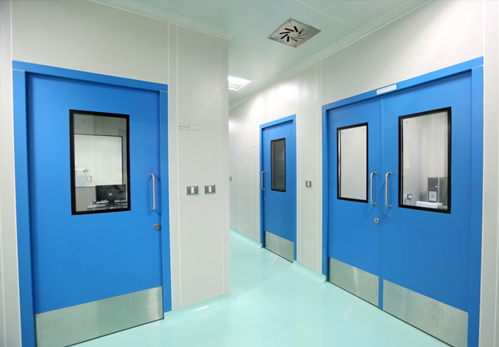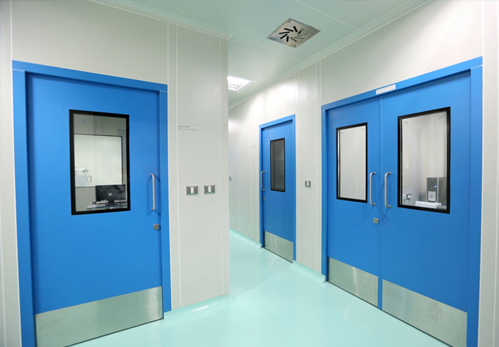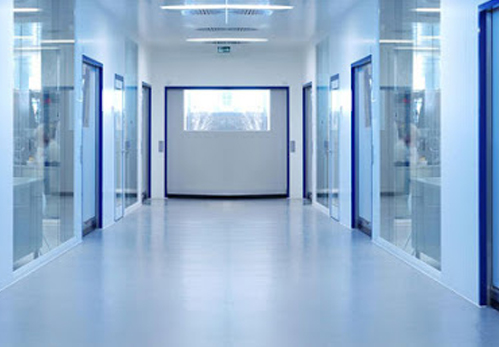Food Processings Cleanrooms are controlled spaces designed to keep out air contaminants of a certain level. Cleanrooms keep air pollutants controlled during manufacturing and operations in industries like E-liquids, science and technology, healthcare, as well as food production.
Aerosol particles, bacteria, pathogens, chemical vapours, fibrous materials and more are types of pollutants that can hurt the manufacturing process in these industries. Our Food Processings Modular Cleanrooms are developed to meet the required standard of the international organisation for standardisation (ISO) 14644-1: 2015.
Food Processings Modular Cleanrooms, built to the ISO 14644-1:2015 specification, are classed from 1 to 9. Each Cleanroom is classed according to the maintained level and size of air particulates in the environment. A Cleanroom with the greatest classification (class 1) will be tested for the smallest particulate sizes and lowest frequency whereas the minimum classification of Cleanroom (Class 9) will have a much higher frequency and larger sized range of air particulates entering the clean air space.

The test method in which these Food Processings Modular Cleanrooms are classified is by use of particle counters, which measures the Particles Per Cubic Metre (PPCMM) by size and quantity. The PPCM of an ISO class 9 Cleanroom is equivalent to atmospheric air (similar to the air of the suburbs) with the removal of much larger particles >5 microns being analysed for assurance of process.
The Class 1 Modular Cleanroom sees to the filtration of much lower air particulate sizes of >0.1 and >0.2 microns, ensuring that the confined space maintains a low level of contamination. The following is an example of the testing method.
A Modular Cleanroom that falls in Class 7 will be tested for the presence of an air particulate size of >0.5 microns where the highest particle count should be capped at 352,000. Failing to maintain the required particle size and count, the Food Processings Cleanroom will have to go through modifications and re-evaluation in order to meet the classification.
Pollution-Free Production
The use of HEPA/ULPA filtering technology is employed to achieve the level of clean air quality in Food Processings Modular Cleanrooms. These technologies have undergone research evaluations to prove that they effectively reduce the quantity and size of air contaminants entering a cleanroom. A positive pressure area is created in the cleanroom when non-filtered air travels through Filter Fan Units (FFUs). The positive pressure is responsible for sustaining the state of clean air that prevents the backflow of polluted air into the Cleanroom via exhaust openings.
The above-mentioned type of Food Processings cleanroom makes sure that only air that has travelled through the FFUs makes it into the internal area ensuring pollution-free production.

Modular Cleanroom Benefits
- Modular Construction
- Quick Assembly Time
- Versatility
- Reconfiguration
- Airflow Control
- Inexpensive Modifications
The Food Processings Cleanroom solution will reduce the likelihood of product contamination and is the first stage of producing a clean air production area. The second steps that should be taken in mitigating contamination are measures that will avoid cleanroom personnel from bringing in pollutants. This can be achieved through the proper use of PPE for cleanrooms such as hair nets, overshoes, and gowning. Fibres and other potential pollutants entering the cleanroom will be further reduced as a result, allowing production and research to go on without interference. Operators of Food Processings Cleanrooms must be adequately trained on contamination reduction processes to keep the Cleanroom safe from contamination.
Cleanroom Design, Build & Validation
- Budgeting and planning
- Engineering, design & layout
- Airflow and filtration design
- Construction and Installation
- Full Certification of our product
- Industry-specific equipment installation
- Validation
The Pharmaceuticals Industry And Saakvee

At Saakvee , we leverage our experience that has spanned over three decades, as well as our talented engineers to deliver the best Food Processings Modular Cleanrooms available. Our Food Processings Modular Cleanrooms have long been known to be durable, reliable, and of the highest build quality. At Saakvee , our project managers control the design, build and validation from end to end assuring that a project is delivered to the customer’s specification and satisfaction. We control the design process and installation allowing us to be one of the most competitive Cleanroom solutions around, boasting our high quality and approachable service.
We derive fulfilment in providing the latest and best technologies, from efficient Engineering Grade aluminium to ultra-bright LED panelling to see your productivity grow. We trust in our ability to deliver quality and long-lasting products to the point that all our Food Processings Modular Cleanrooms always come with a five-year warranty.
Industry Requirements
Cleanrooms are a critical part of the research and production processes in certain industries to ensure contamination-free production.
The Cleanroom is crucial for reducing particulates in the production environment via air filtration. Food production, semiconductor production, science and technology, medical devices manufacturing, as well as electronics production are some of the industries where Cleanrooms are used.

We’re always dedicated to make sure you invest in the Cleanroom that is most effective for your production or research purposes. Further guidance can be provided if you need assistance with choosing the right standard of Food Processings Cleanroom for your industry.
Our Food Processings Modular Cleanrooms are constructed to meet the standards of the ISO 14644-1: 2015. Cleanrooms of this standard fall in different classes – from ISO 1-9. The size and quantity of air particulates in a Cleanroom will determine the class it belongs to. Tests for the smallest sizes of particulates will be carried out for the highest classification (class 1) while class 9, which is the least classification, has a requirement for a higher prevalence and larger size of contaminants present in the clean air environment.
To the determine the class of a Modular Cleanroom, particle counters are used to measure the size and quantity of particulates in Particles Per Cubic Metres (PPCM). Every particle counter determines the size and quantity of air particulates. ISO 1 rated cleanrooms are evaluated for the extraction of small air particulates >0.1 microns and >0.2 microns whereas an ISO 9 cleanroom, which has a similar PPCM to suburban air, will be tested for the removal of larger air contaminants >5 microns.
Modular Cleanroom Services
- Design & Build
- Free Site Survey
- Free Design Service
- Cleanroom Planning
- Construction and Installation
- CNC Engineered
- Training & Support
- Discounted Service Contracts
- Remedial Works
- Panel Repairs
- Alternations
- BMS Management
- Cleanroom Certification
- Differential Pressure Qualification
- Servicing Testing Validation
- Smoke Testing
- DOP Testing
Containment Solutions

A containment solution is suitable for you if you have a hazardous substance that needs to be removed via a filter before reaching the outside air. This can be set up in a Cleanroom that both protects products by introducing filtered air and contains hazardous materials by extracting them through a HEPA (High-Efficiency Particulate Air), ULPA (Ultra-Low Particulate Air) or carbon filter. With our help at Saakvee, you can have containment solutions installed in your modular cleanroom that will see to the prevention of hazardous substances entering the outside air, keeping you out of the crosshairs of regulators.
Each containment solution we provide is unique as not two hazardous materials are the same and vary on quantities dependent on the use. This means that the level of containment can change from customer to customer. We’ll consult with you to make sure we deliver the required system for your use.
Airflow And Filtration
Our Cleanrooms are designed to be compliant to the specified ISO 14644-1:2015 grading. With this in mind, we take into consideration the level of air filtration required and the end function of the cleanroom. The level of air filtration required is determined by the air changes per hour (ACH), this determines how many Filter Fan Units are to be used in the cleanroom. What we also determine by the strategic positioning of the FFUs and exhausts is the flow of air around the cleanroom. This can mean the difference between a uni-directional (laminar flow) and a non-unidirectional (turbulent flow) airflow around a cleanroom, potentially leading to a contaminated product. With this in mind, we can greatly increase the number of ACH and control the air flow within the cleanroom.
Filtration of air is controlled by our ultra-quiet, high-efficiency filtration modules. These filtration modules automatically compensate for a build-up of dust and other materials that occur over time within a HEPA/ULPA filter increasing the fan speed to reach the set flow rate. This increases the life of the filter, reducing cost overtime for the end user.
Cleanroom Features
- GMP
- ISO 4-9
- ISO 14644
- Low Power Consumption
- Environmentally Friendly
- HEPA Filters
- Air Filtration
- Fan Filter Units
- Cleanroom Ceiling System
- Temperature Control
- Access Control
- Inter Lock Door Systems
- Air Showers
- Unidirectional Airflow
- Desiccator Cabinets
- Horizontal Flow Wall Modules
- Horizontal Laminar Flow Clean Benches
- Laminar flow cabinets
- Laminar Flow Canopy
Cleanrooms Customised To Your Needs
At Saakvee Technologies there is no such thing as a standard modular cleanroom. Each Cleanroom we design is made to fit your unique work conditions and is designed with your needs in mind. We make each modular Cleanroom to order and make you part of the design process.
With Saakvee Technologies you have the option of doing almost anything with a cleanroom design. This means that your Cleanroom can be many shapes and sizes fitting the most obscure of rooms and can have a range of finishes. We have yet to find a design that we could not accommodate.

Our customisable options mean that all components of the Cleanroom such as doors, windows, lighting, ceilings and filtrations can be altered to better suit your needs. You also have the option of installing furniture, air showers, pass through chambers, fire suppression, air-conditioning and much, much more. We pride ourselves in being able to meet design requests however unique in shape and size they may be.
